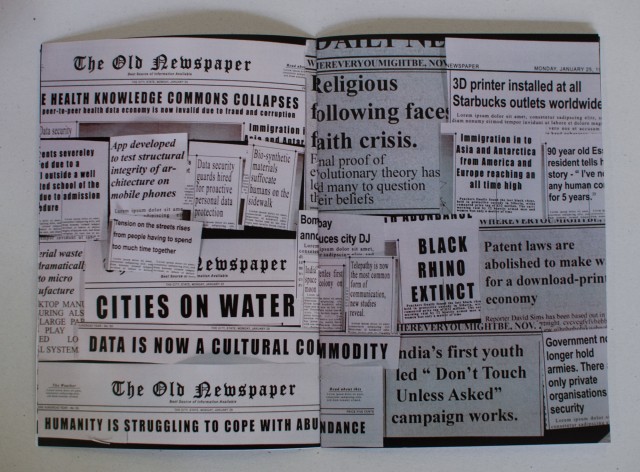Future Cities: Which Future?

Ben Barker
29th March 2014
The future has a lot in store for cities. Planners and architects will soon see some weird briefs. We’ll make settlements on the moon, in digital space and roaming settlements that graze the landscape for resources. Opportunities will shape our urban futures in exciting ways, whilst impending challenges will redefine how we understand urban. The decline in the efficacy of antibiotics will affect how we live together and rising water levels will terraform cities from London to the Ganges Delta. Designers and makers will have a responsibility to explore what those futures are, and understand how we’ll live when they get here.
Bruce Sterling’s assertion, in his closing notes at SxSW, that the future will be old people in cities, frightened of the sky, is an extrapolation of the challenges of climate change, urban migration and an ageing population. It’s a possible future that hasn’t been rendered in such folk terms before. In that talk Sterling also announced that he would become a maker of things, his decision to move from words to objects shows his understanding of the power of design, it puts the thing in your hand and the idea in a form you can discuss.
At the start of March I was part of the Unbox Future Cities Lab, a two weeks programme held at the National Institute of Design in Ahmedabad, India. 36 researchers, designers and makers from the Uk and India came together around theme of Future Cities. The brief was almost impossibly open: collect people working on city based projects using diverse processes and get them thinking about cities together. We know there is a responsibility for practitioners to explore the forces that might split, weave and define the many possible threads of the future, the question is which futures?
First we have to define what the opportunities and trends facing our collective futures are. Most will happen on some scale, somewhere, but which are likely to have the greatest impact? We spent a day creating headlines from futures we both anticipated and hoped for. The cross-cultural record of the future we created will be one of my enduring records of the trip, a zeitgeist of expectation from two continents. Importantly, as with Sterlings assertion, closer inspection of those ideas reveals that a lot of them aren’t as far away as they first seem.
We also have to bring these ideas to life. Whether that’s through the design fiction seen in the work of Dunne and Raby or in the alternate realities of games and film. If we don’t imagine and then realise these futures then we are left working under the assumed notion of a shared values of the future. We have to design futures that encapsulate the values we want. We have to be frank about what and only by making them can we defend or avert them.
When Mayor Antanas Mockus of Bogota made all his traffic warden dress up as Mimes, he wasn’t saying this is the future, he was saying what if we understood the role of the city differently. One of our best known working prototype future cities might be Disney Land, Walt Disney created a a testing model for our future urban spaces in the form of a theme park. I want more weird future testing spaces, if Unbox left me thinking one thing, it’s lets bring to life more of these possible future cities. Below are a selection of the spaces we began to describe at Unbox, the document containing more detail can be seen here.
The Data City – Due to it’s climate and proximity to energy resources, a Siberian town becomes home to the worlds largest data centre. The finance industry move in driven by a need for reduced latency in algorithmic trading and briefly make it the banking capital of the Eurasian continent. Who moves in after them?
The City after Antibiotics – LA becomes obsessed with personal hygiene transparency and sterilisation as antibiotics are deemed no longer effective against the vast majority of diseases and bacteria. How do people move around and indicate their good health in disease obsessed city?
The First Settlers at Chernobyl – In the distant future, with uninhabited land at a premium, the first planning permission is received for the irradiated blast zone around Chernobyl after lying uninhabited for nearly 600 years. What does this application look like..

